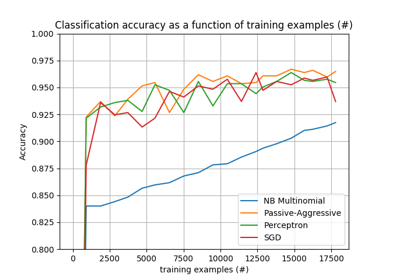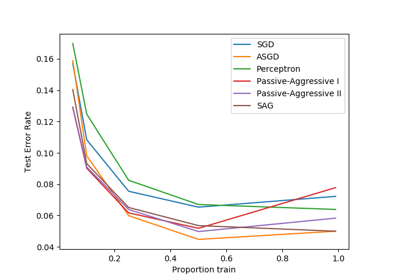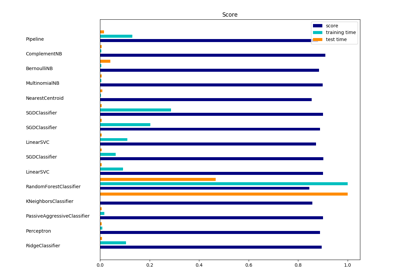sklearn.linear_model.Perceptron¶
-
class
sklearn.linear_model.Perceptron(penalty=None, alpha=0.0001, fit_intercept=True, max_iter=None, tol=None, shuffle=True, verbose=0, eta0=1.0, n_jobs=None, random_state=0, early_stopping=False, validation_fraction=0.1, n_iter_no_change=5, class_weight=None, warm_start=False, n_iter=None)[source]¶ Read more in the User Guide.
Parameters: - penalty : None, ‘l2’ or ‘l1’ or ‘elasticnet’
The penalty (aka regularization term) to be used. Defaults to None.
- alpha : float
Constant that multiplies the regularization term if regularization is used. Defaults to 0.0001
- fit_intercept : bool
Whether the intercept should be estimated or not. If False, the data is assumed to be already centered. Defaults to True.
- max_iter : int, optional
The maximum number of passes over the training data (aka epochs). It only impacts the behavior in the
fitmethod, and not the partial_fit. Defaults to 5. Defaults to 1000 from 0.21, or if tol is not None.New in version 0.19.
- tol : float or None, optional
The stopping criterion. If it is not None, the iterations will stop when (loss > previous_loss - tol). Defaults to None. Defaults to 1e-3 from 0.21.
New in version 0.19.
- shuffle : bool, optional, default True
Whether or not the training data should be shuffled after each epoch.
- verbose : integer, optional
The verbosity level
- eta0 : double
Constant by which the updates are multiplied. Defaults to 1.
- n_jobs : int or None, optional (default=None)
The number of CPUs to use to do the OVA (One Versus All, for multi-class problems) computation.
Nonemeans 1 unless in ajoblib.parallel_backendcontext.-1means using all processors. See Glossary for more details.- random_state : int, RandomState instance or None, optional, default None
The seed of the pseudo random number generator to use when shuffling the data. If int, random_state is the seed used by the random number generator; If RandomState instance, random_state is the random number generator; If None, the random number generator is the RandomState instance used by np.random.
- early_stopping : bool, default=False
Whether to use early stopping to terminate training when validation. score is not improving. If set to True, it will automatically set aside a fraction of training data as validation and terminate training when validation score is not improving by at least tol for n_iter_no_change consecutive epochs.
New in version 0.20.
- validation_fraction : float, default=0.1
The proportion of training data to set aside as validation set for early stopping. Must be between 0 and 1. Only used if early_stopping is True.
New in version 0.20.
- n_iter_no_change : int, default=5
Number of iterations with no improvement to wait before early stopping.
New in version 0.20.
- class_weight : dict, {class_label: weight} or “balanced” or None, optional
Preset for the class_weight fit parameter.
Weights associated with classes. If not given, all classes are supposed to have weight one.
The “balanced” mode uses the values of y to automatically adjust weights inversely proportional to class frequencies in the input data as
n_samples / (n_classes * np.bincount(y))- warm_start : bool, optional
When set to True, reuse the solution of the previous call to fit as initialization, otherwise, just erase the previous solution. See the Glossary.
- n_iter : int, optional
The number of passes over the training data (aka epochs). Defaults to None. Deprecated, will be removed in 0.21.
Changed in version 0.19: Deprecated
Attributes: - coef_ : array, shape = [1, n_features] if n_classes == 2 else [n_classes, n_features]
Weights assigned to the features.
- intercept_ : array, shape = [1] if n_classes == 2 else [n_classes]
Constants in decision function.
- n_iter_ : int
The actual number of iterations to reach the stopping criterion. For multiclass fits, it is the maximum over every binary fit.
See also
Notes
Perceptronis a classification algorithm which shares the same underlying implementation withSGDClassifier. In fact,Perceptron()is equivalent to SGDClassifier(loss=”perceptron”, eta0=1, learning_rate=”constant”, penalty=None).References
https://en.wikipedia.org/wiki/Perceptron and references therein.
Examples
>>> from sklearn.datasets import load_digits >>> from sklearn.linear_model import Perceptron >>> X, y = load_digits(return_X_y=True) >>> clf = Perceptron(tol=1e-3, random_state=0) >>> clf.fit(X, y) Perceptron(alpha=0.0001, class_weight=None, early_stopping=False, eta0=1.0, fit_intercept=True, max_iter=None, n_iter=None, n_iter_no_change=5, n_jobs=None, penalty=None, random_state=0, shuffle=True, tol=0.001, validation_fraction=0.1, verbose=0, warm_start=False) >>> clf.score(X, y) # doctest: +ELLIPSIS 0.946...
Methods
decision_function(X)Predict confidence scores for samples. densify()Convert coefficient matrix to dense array format. fit(X, y[, coef_init, intercept_init, …])Fit linear model with Stochastic Gradient Descent. get_params([deep])Get parameters for this estimator. partial_fit(X, y[, classes, sample_weight])Fit linear model with Stochastic Gradient Descent. predict(X)Predict class labels for samples in X. score(X, y[, sample_weight])Returns the mean accuracy on the given test data and labels. set_params(*args, **kwargs)Set the parameters of this estimator. sparsify()Convert coefficient matrix to sparse format. -
__init__(penalty=None, alpha=0.0001, fit_intercept=True, max_iter=None, tol=None, shuffle=True, verbose=0, eta0=1.0, n_jobs=None, random_state=0, early_stopping=False, validation_fraction=0.1, n_iter_no_change=5, class_weight=None, warm_start=False, n_iter=None)[source]¶ Initialize self. See help(type(self)) for accurate signature.
-
decision_function(X)[source]¶ Predict confidence scores for samples.
The confidence score for a sample is the signed distance of that sample to the hyperplane.
Parameters: - X : array_like or sparse matrix, shape (n_samples, n_features)
Samples.
Returns: - array, shape=(n_samples,) if n_classes == 2 else (n_samples, n_classes)
Confidence scores per (sample, class) combination. In the binary case, confidence score for self.classes_[1] where >0 means this class would be predicted.
-
densify()[source]¶ Convert coefficient matrix to dense array format.
Converts the
coef_member (back) to a numpy.ndarray. This is the default format ofcoef_and is required for fitting, so calling this method is only required on models that have previously been sparsified; otherwise, it is a no-op.Returns: - self : estimator
-
fit(X, y, coef_init=None, intercept_init=None, sample_weight=None)[source]¶ Fit linear model with Stochastic Gradient Descent.
Parameters: - X : {array-like, sparse matrix}, shape (n_samples, n_features)
Training data
- y : numpy array, shape (n_samples,)
Target values
- coef_init : array, shape (n_classes, n_features)
The initial coefficients to warm-start the optimization.
- intercept_init : array, shape (n_classes,)
The initial intercept to warm-start the optimization.
- sample_weight : array-like, shape (n_samples,), optional
Weights applied to individual samples. If not provided, uniform weights are assumed. These weights will be multiplied with class_weight (passed through the constructor) if class_weight is specified
Returns: - self : returns an instance of self.
-
get_params(deep=True)[source]¶ Get parameters for this estimator.
Parameters: - deep : boolean, optional
If True, will return the parameters for this estimator and contained subobjects that are estimators.
Returns: - params : mapping of string to any
Parameter names mapped to their values.
-
loss_function¶ DEPRECATED: Attribute loss_function was deprecated in version 0.19 and will be removed in 0.21. Use
loss_function_instead
-
partial_fit(X, y, classes=None, sample_weight=None)[source]¶ Fit linear model with Stochastic Gradient Descent.
Parameters: - X : {array-like, sparse matrix}, shape (n_samples, n_features)
Subset of the training data
- y : numpy array, shape (n_samples,)
Subset of the target values
- classes : array, shape (n_classes,)
Classes across all calls to partial_fit. Can be obtained by via np.unique(y_all), where y_all is the target vector of the entire dataset. This argument is required for the first call to partial_fit and can be omitted in the subsequent calls. Note that y doesn’t need to contain all labels in classes.
- sample_weight : array-like, shape (n_samples,), optional
Weights applied to individual samples. If not provided, uniform weights are assumed.
Returns: - self : returns an instance of self.
-
predict(X)[source]¶ Predict class labels for samples in X.
Parameters: - X : array_like or sparse matrix, shape (n_samples, n_features)
Samples.
Returns: - C : array, shape [n_samples]
Predicted class label per sample.
-
score(X, y, sample_weight=None)[source]¶ Returns the mean accuracy on the given test data and labels.
In multi-label classification, this is the subset accuracy which is a harsh metric since you require for each sample that each label set be correctly predicted.
Parameters: - X : array-like, shape = (n_samples, n_features)
Test samples.
- y : array-like, shape = (n_samples) or (n_samples, n_outputs)
True labels for X.
- sample_weight : array-like, shape = [n_samples], optional
Sample weights.
Returns: - score : float
Mean accuracy of self.predict(X) wrt. y.
-
set_params(*args, **kwargs)[source]¶ Set the parameters of this estimator.
The method works on simple estimators as well as on nested objects (such as pipelines). The latter have parameters of the form
<component>__<parameter>so that it’s possible to update each component of a nested object.Returns: - self
-
sparsify()[source]¶ Convert coefficient matrix to sparse format.
Converts the
coef_member to a scipy.sparse matrix, which for L1-regularized models can be much more memory- and storage-efficient than the usual numpy.ndarray representation.The
intercept_member is not converted.Returns: - self : estimator
Notes
For non-sparse models, i.e. when there are not many zeros in
coef_, this may actually increase memory usage, so use this method with care. A rule of thumb is that the number of zero elements, which can be computed with(coef_ == 0).sum(), must be more than 50% for this to provide significant benefits.After calling this method, further fitting with the partial_fit method (if any) will not work until you call densify.




